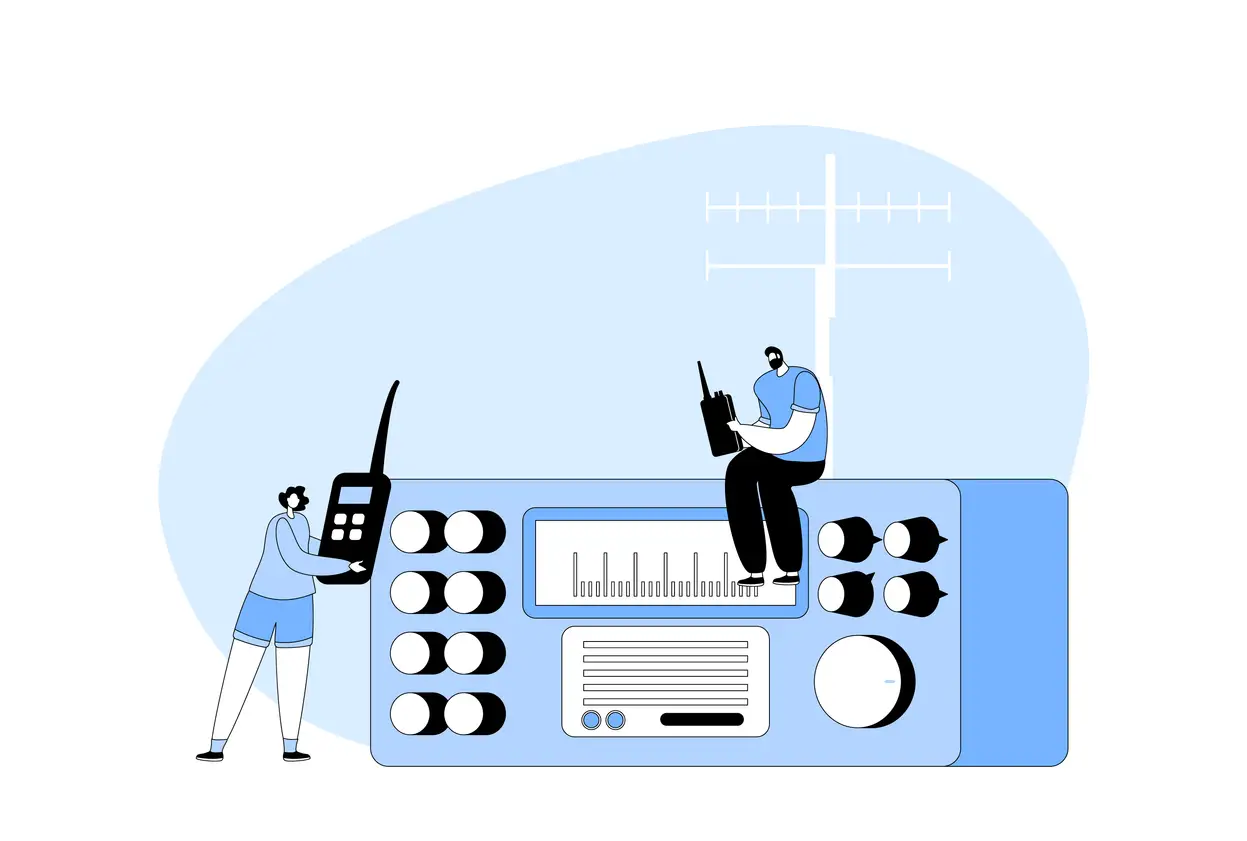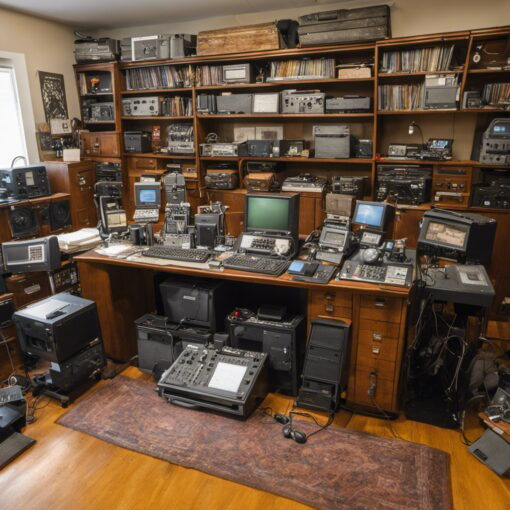Ham radio, also known as amateur radio, is a diverse and fascinating hobby that connects people from all around the world. Encompassing a wide range of communication modes and frequencies, ham radio operators can engage in various activities, such as satellite communication, contesting, and emergency preparedness. As with any hobby or discipline, there are certain best practices and operating procedures that should be followed to ensure effective and courteous communication among users.
In order to maintain a high quality of communication and foster a sense of cooperation among ham radio operators, it is essential to adhere to some basic guidelines. These include familiarizing oneself with the proper operating procedures, practicing good etiquette, and understanding the specificities of different communication modes. Operating Ethics and Operating Procedures for the Radio Amateur is a comprehensive document that can serve as a valuable reference for both new and experienced operators in navigating the etiquette and procedures of amateur radio operation.
By following best practices and being respectful of other users, ham radio operators can enjoy the diverse experiences and benefits that this hobby offers. Not only does it provide an opportunity for learning and skill development, but it also fosters a sense of community and global connection among those who share this unique passion.
Ham Radio Basics
Ham radio, also known as amateur radio, is a popular hobby and service that allows individuals to communicate with others across the globe. The amateur radio community is vast and diverse, and many operators take pride in developing their skills, sharing information, and offering assistance in emergencies. This section will cover the basics of ham radio, including the roles of radio societies and the differences between Technician and General licenses.
Amateur Radio Community
The amateur radio community consists of individuals who are passionate about radio communication and strive to uphold a sense of camaraderie and cooperation among fellow operators. Ham radio enthusiasts are often involved in various operating procedures, exploring new techniques and technologies to continually advance their skills. They also place a strong emphasis on ethical conduct, ensuring that the shared airwaves are used responsibly and respectfully.
Radio Societies
Radio societies, such as the ARRL, serve to organize and support the amateur radio community. These organizations provide resources, guidelines, and training for new and experienced operators alike. They also advocate for the interests of ham radio operators on a national and international level, promoting responsible conduct and facilitating communication during emergencies or major events.
Technician and General Licenses
In many countries, aspiring ham radio operators are required to obtain a license to ensure they have the necessary knowledge and skills to operate their equipment safely and responsibly. In the United States, the Technician and General licenses are two commonly pursued amateur radio licenses.
The Technician license is the entry-level permit that grants operators access to a limited range of frequencies and communication modes. To obtain this license, individuals must pass an examination covering basic electronics, radio theory, and regulations.
The General license offers a broader range of frequencies and privileges, enabling operators to communicate over long distances and access more advanced operating procedures. Upgrading to a General license requires passing an additional examination that covers more in-depth topics in radio theory and regulations.
By understanding and adhering to established best practices, ham radio operators contribute to a positive and productive amateur radio community. Obtaining the appropriate license and engaging with radio societies helps promote responsible and ethical conduct on the airwaves, ensuring a rewarding experience for all involved.
Operating Procedures and Ethics
Universal Guide
The ham radio operating procedures can be found in the Ethics and Operating Procedures for the Radio Amateur document, written by John Devoldere, ON4UN, and Mark Demeuleneere, ON4WW. This comprehensive guide was created to become a universal reference for both newcomers and experienced operators alike, helping them maintain high standards of operating ethics and behavior.
Ethics and Operating Procedures for the Radio Amateur
The Ethics and Operating Procedures for the Radio Amateur covers various aspects of the ham radio operation, including:
- Techniques: Frequency selection, calling CQ, and working DX.
- Communication: Signal report (RST), making contacts, and QSL cards.
- Operating in contests: ‘Run’ operating, ‘search and pounce’ operating, and logging.
The procedures followed by a ham radio operator should be guided by a defined code of conduct. Operators are encouraged to:
- Always listen and tune carefully to avoid causing interference.
- Operate only within the technical limits of their equipment and license privileges.
- Respect the rules of the frequency bands.
- Be courteous and patient in all communications.
- Give priority to emergency signals.
Language and Courteous Communications
Since ham radio is an international hobby, the primary language used for communications is English. However, it is acceptable to use other languages when communicating with operators who speak those languages.
It is essential to maintain courteous and respectful communication, even when facing difficult or contentious conversations. Remember to:
- Keep the language simple and clear.
- Be patient with newcomers and offer guidance when needed.
- Address any disagreements or conflicting opinions in a calm and constructive manner.
By following the guidelines provided in the Ethics and Operating Procedures for the Radio Amateur and adhering to the recommended code of conduct, ham radio operators can ensure a positive and enjoyable experience for all participants.
Equipment and Setup
When setting up a ham radio station, it’s important to have the appropriate equipment and understand how to properly set everything up. This section will discuss the essential components of a ham radio station, such as radio communication equipment, power supply and batteries, as well as microphones and antennas.
Radio Communications Equipment
The core component of any ham radio station is the radio communications equipment. This includes the transceiver (a combination of a transmitter and receiver) and a device for decoding and encoding signals, like a digital mode interface for use in modes such as QSO. When choosing your equipment, consider your desired communication range, the bands you’re interested in, and whether you’ll be using digital or analog modes. It is essential to properly configure your equipment, including adjusting settings like your call sign, QTH, and other necessary information. Keep up-to-date with ham radio news to stay informed about the latest equipment and technology improvements.
Power Supply and Batteries
A reliable power supply is necessary for your ham radio equipment’s optimal performance. Choose a regulated power supply that can provide a consistent voltage level to avoid damaging your electronics. Ensure that your power supply can handle the current draw of your equipment. Additionally, it’s a good idea to have a backup power source, like batteries, in case of a power outage or if you plan to operate your station remotely.
- Regulated power supply
- Adequate current handling
- Backup power source (batteries)
Microphones and Antennas
Good-quality microphones are crucial for clear audio communication during your ham radio operations. Depending on your preferences and operating conditions, you can choose between different types, such as handheld, boom-mounted, or desk microphones. Consider investing in a noise-canceling microphone to eliminate background noise, especially in crowded environments or contest situations.
Antennas are another essential component of a ham radio station. The type and installation of your antenna will significantly impact your station’s overall performance and communication range. Research different antenna designs and choose the best one that fits your needs and location. Ensure that your antenna is adequately installed and maintained to optimize its efficiency and prevent damage from weather and other elements.
- High-quality microphones
- Noise-canceling for crowded environments
- Antennas for effective communication
- Selection based on needs and location
- Proper installation and maintenance
On-air Activities
Using Call Signs and Q-Codes
Using your call sign correctly is crucial as an amateur radio operator. Always identify yourself with your full call sign, per regulations and courteous behavior. Furthermore, being familiar with Q-Codes, which are shorthand codes used worldwide, can make your on-air communication efficient. Common Q-codes include:
- QSO: Making a contact
- QSL: Confirming receipt of a message
- QSY: Changing frequency
- QTH: Location
Making QSOs
When making QSOs (contacts) with other hams, ensure you maintain a respectful and friendly tone. It’s essential to follow the guidelines established by John Devoldere (ON4UN) and Mark Demeuleneere (ON4WW), which were accepted by the International Amateur Radio Union (IARU) during the regional IARU meetings. Some key points to remember while making QSOs are:
- Listen before transmitting
- Do not interrupt existing QSOs
- Verify the frequency is available before calling CQ
- Respect other operators’ signal reports and feedback
Participating in Nets and Traffic
Being involved in nets, or on-air gatherings of amateur radio operators, helps enrich the amateur radio community. Ensure you follow the protocols and procedures established by the net control station (NCS). Participation may include check-ins, sharing information, or handling traffic.
Traffic refers to messages passed between amateur radio operators. Proper handling of traffic is important, especially in emergency situations or during special events. Be prepared to relay messages by following the established format and protocols.
By adhering to these guidelines and best practices, you contribute to a positive and productive amateur radio experience for both yourself and fellow operators.
Specialized Ham Radio Operations
Repeaters and HF Bands
Repeaters are essential devices in ham radio that extend the range of radio communications. They receive signals on one frequency and retransmit them on another frequency, allowing ham radio operators to communicate over more extensive distances. When using repeaters, always follow proper etiquette by providing your name and call sign when entering and leaving the conversation. Listen first to ensure you aren’t interrupting an existing QSO (a chat between two radio operators).
The HF (High Frequency) bands are another aspect of specialized ham radio that offers opportunities to converse with operators worldwide. Ensure your equipment, power supply, and antennas are adequate for HF communications. Familiarize yourself with Q-codes, such as QRN, which refers to noise interference, and BT, meaning “I pause for you to reply.” When calling CQ (seeking a contact) on the HF bands, maintain a courteous and friendly demeanor, as it is a shared space for hobbyists around the globe.
Emergency Services
Ham radio operators have a long history of providing essential support during emergencies, often through Radio Amateur Civil Emergency Service (RACES) networks. Be prepared to handle various languages, such as French, if that would be helpful. If you become involved with RACES, prioritize critical information during radio communication and abide by proper operating procedures. Regularly participate in practice exercises to sharpen your emergency communication skills.
Skywarn
Skywarn is a volunteer program in which ham radio operators support the National Weather Service (NWS) by submitting real-time weather observations during severe weather events. Properly trained Skywarn operators are essential in relaying accurate, timely information that may save lives and property. Keep your Skywarn training and skills up-to-date if you choose to participate in this critical public service.
Remember, maintaining a professional, courteous demeanor is crucial when dealing with specialized ham radio operations – both on the air and off. These practices help to ensure a positive experience for all ham radio operators and improve the overall quality of radio communications within the community.
Resources and Further Learning
Printed and Online Material
In addition to online resources, there are several printed materials available for learning more about ham radio operating procedures. The ARRL offers a comprehensive guide called the “ARRL Operating Manual”, which covers many popular types and styles of operating and operating activities. Another valuable reference is the “Ethics and Operating Procedures for the Radio Amateur” document by John Devoldere, ON4UN, and Mark Demeuleneere, ON4WW. This resource is provided in PDF and Powerpoint formats and is available in multiple languages, including Dutch.
International Ham Radio News
To stay updated with international ham radio news and events, it is essential to engage with radio societies and organizations. The ARRL and RSGB are excellent starting points to access worldwide news, operating ethics, and best practices. You can also visit forums such as Reddit’s r/amateurradio for community-driven discussions and advice.
Contest Calendar
A contest calendar provides information about various ham radio competitions worldwide, helping operators optimize their skills and knowledge. These events can be an excellent opportunity to practice proper operating etiquette, learn new techniques, and adhere to the rules and regulations set forth by international and national authorities, such as the FCC’s Part 97 for amateur radio operators in the USA.
DX Summit
The DX Summit is a platform where ham radio enthusiasts can share information about DX stations, meetings, and other relevant activities. It allows operators to keep track of DX cluster spots, facilitating efficient communication and the ability to prioritize contacts. This resource is especially useful for CW operators and those who want to practice their Q signals and other operating procedures.
These resources collectively provide essential information, guidance, and updates on ham radio operating procedures, assisting amateur radio operators in enhancing their skills and staying compliant with regulations. By utilizing these tools, one can ensure an enjoyable and successful ham radio experience.
Frequently Asked Questions
Proper etiquette during QSO
When engaging in a QSO (conversation) with another ham radio operator, it’s essential to follow proper etiquette to ensure a pleasant experience for both parties. Begin by identifying yourself with your call sign and giving the person’s call sign you are contacting. Speak clearly, avoid interrupting or talking over others, and offer a signal report to let the other operator know how well their signal is coming through. Keep conversations friendly and civil, and avoid discussing controversial topics that could lead to disagreements.
How to break into a conversation
If you want to join an ongoing ham radio conversation, you need to break in politely. Wait for a pause in the conversation and then transmit your call sign to let the involved parties know you’re there. Once acknowledged, proceed with your message or contribution to the discussion. Remember not to interrupt, and always offer a friendly and respectful tone when breaking into an ongoing conversation.
Essential frequencies to program
To get the most out of your ham radio experience, it’s essential to have the correct frequencies programmed into your transceiver. Begin by programming local repeaters and simplex channels (for direct, non-repeater communications). You’ll also want to include popular HF bands like 40m and 20m that are commonly used for long-distance communications. Additional frequencies to consider are the National Simplex Frequencies, emergency communications frequencies, and international calling frequencies. You can also consult online resources like ARRL’s website for more information on recommended frequencies.
Morse code requirements
Morse code was once a mandatory requirement for ham radio operators but is no longer required for licensing in most countries, including the United States. However, learning Morse code remains valuable to many ham radio operators who enjoy using it as a mode of communication, especially for long-distance and weak signal conditions. Those who want to learn Morse code can benefit from online resources, smartphone apps, and local clubs offering instructional courses.
Contesting tips for beginners
Ham radio contests are an enjoyable way to test your skills, meet new operators, and learn about different aspects of radio communication. Beginners can ease into contesting by starting with smaller, regional contests before participating in larger, national or international contests. Here are some tips for contesting success:
- Prepare your station with necessary tools and frequency lists.
- Familiarize yourself with the contest’s rules, such as exchange requirements and scoring.
- Use logging software, like N1MM Logger, to streamline recording contact information.
- Get to know common contesting best practices, such as managing pile-ups and tuning for maximum efficiency.
Building a successful ham radio
Constructing a successful ham radio station involves a combination of equipment, antenna systems, and accessory components. Start by researching the ideal transceiver for your needs, focusing on factors like frequency capabilities, power requirements, and size. Next, develop a suitable antenna system, whether it’s a simple dipole antenna for HF operation or a more complex beam antenna for VHF/UHF communications. Finally, add accessories such as a power supply, SWR meter, and antenna tuner to optimize performance. Consulting online resources, including the ARRL’s Operating Manual, and seeking advice from experienced operators will go a long way in building a successful ham radio station.





